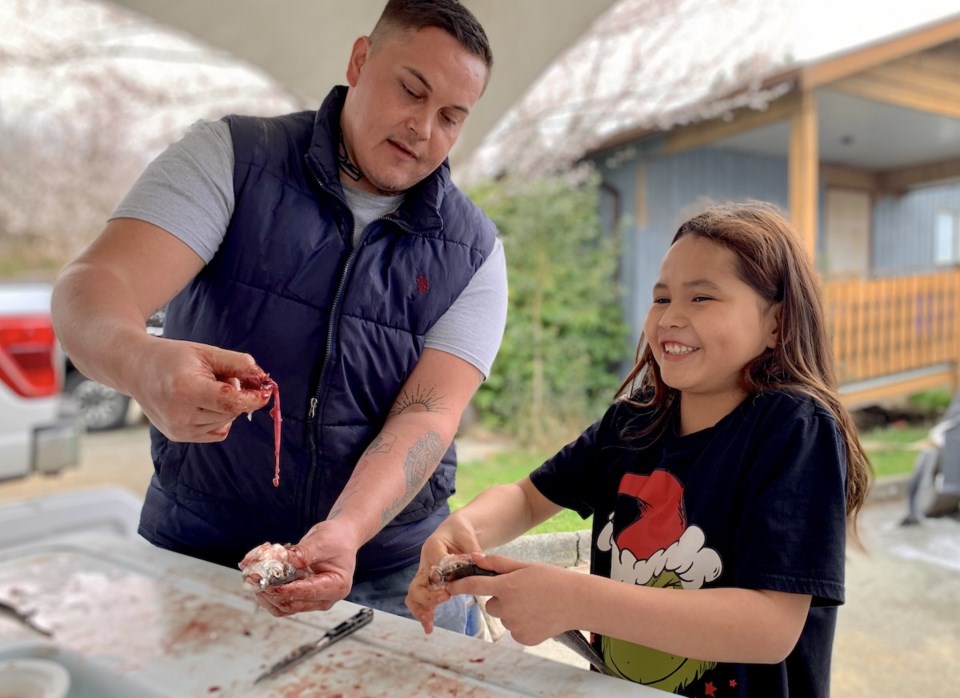Joshua Charleson throws back the lid of an enormous cooler to reveal a cache of hundreds of freshly harvested silver herring that sparked “oohs” of excitement from a crowd leaning in to get a look.
Charleson, or 岣siik史aay虛ak, then promptly put folks to work, teaching them how to gut and prep the fish for an Indigenous smokehouse.
The hands-on workshop was just one of many at the two-day Island Indigenous Food Gathering hosted recently by the Ahousaht Nation in Tseshaht Territory near Port Alberni, British Columbia.
The food summit, involving First Nations from Vancouver Island and the B.C. coast, was a cultural exchange and celebration aimed at strengthening food sovereignty and Indigenous communities' response to climate change and other emergency situations.
First, at Charleson’s session, he demonstrates the rapid-fire technique learned from his mother and sisters to process the fish, hooking out the gill plate before using his finger to clean out the fish.
“You just kind of swoop around and pull,” he said. “Then break this piece and then, stick your finger in and just run it right over the belly like that.”
Traditional knowledge and Pacific herring were on the menu at the recent Island Indigenous Food Gathering.
Picking up a small knife, he deftly fillets the fish from its backbone in two swipes, leaving the head and tail connected for easy hanging off cedar sticks in the smokehouse.
People gather round the cutting table to try it out themselves with coaching from Charleson, who is from the Hesquiaht Nation and relationships director with the Coastal Restoration Society.
Some folks were from other areas of the coast without access to herring, and others were young people eager to learn traditional food skills.
Eight-year-old Kinsley from Victoria dove right in, not letting her momentary squeamishness get in her way. Several teens also stepped up to learn or sharpen their fish processing skills.
The enthusiasm and engagement young people show for learning Indigenous food skills is a driving motivation for passing on knowledge that he had the opportunity to learn, Charleson said. He’s also created how-to social media videos with his wife to teach people how to smoke fish.
“This is exactly what I want. They are my target audience and I think it’s really important to pass it down to the next generations,” he said.
People at a recent Indigenous food sovereignty summit learned how to prepare and smoke Pacific herring.
Growing up in the remote community of Hot Springs Cove, Charleson learned where and when to harvest herring and other Indigenous foods from his father and uncles.
Sustainability is a core focus of Indigenous food harvesting and preserving food security, he said.
“It’s really important to harvest things in a respectful way.”
Pacific herring stocks on the west coast of Vancouver Island collapsed under the pressure of commercial fishing two decades ago and are only recently starting to bounce back after Nuu-chah-nulth nations fought to get industrial fishing closures in place, he said.
“It’s really nice to see the resource actually coming back,” he said.
“It’s really important for all the people that missed out over the last 15 or 20 years to relearn these skills.”
Ahousaht elder ciisma (Patti Frank) schools participants at an Indigenous food summit about how to prepare herring.
Before Charleson wrapped up the herring workshop by outlining the cold smoke method he uses, Ahousaht elder ciisma (Patti Frank) swooped up to the fish-cutting table to share how she learned to process herring as a child with her eight brothers.
It was a skill she put to use to feed her kids, ciisma said, noting she used the sharpened leg bone of a deer as a filet knife.
Her name means “gathering food for my family,” ciisma said.
“My brother once said if you offer a prayer of thanks before eating, you never go hungry. And you know, we never did.”




